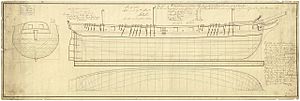HMS Levant (1813) facts for kids

Levant
|
|
Quick facts for kids History |
|
|---|---|
| Name | HMS Levant |
| Ordered | 18 November 1812 |
| Builder | William Courtney, Chester |
| Laid down | January 1813 |
| Launched | 8 December 1813 |
| Completed | By 22 April 1814 |
| Fate | Broken up by 9 October 1820 |
| General characteristics | |
| Class and type | Rated 20-gun Cyrus-class sixth rate |
| Tons burthen | 464 42⁄94 bm |
| Length |
|
| Beam | 29 ft 10 in (9.09 m) |
| Draught | 9 ft 6 in (2.90 m) |
| Depth of hold | 8 ft 6 in (2.59 m) |
| Complement | 135 |
| Armament | 2 x 6-pounders bow chasers + 20 x 32 pounder carronades |
HMS Levant was a British warship with 20 guns. She was part of the Royal Navy and was built in Chester. Levant was a Cyrus-class post ship, which was a type of smaller warship.
During the War of 1812, the American ship USS Constitution captured or destroyed five British warships, and Levant was one of them. However, the British soon recaptured her. After 1817, she was called a sloop of war, which is another type of small warship. Levant was taken apart in 1820.
Life of HMS Levant
Levant was one of 16 ships in her class. These ships were designed based on a French ship the British had captured. Levant was launched in December 1813.
Her first captain was Alexander Jones. Later, Captain George Douglas took command on April 28, 1814. Under Captain Douglas, Levant sailed from England to Quebec in Canada, and then to Gibraltar.
Battle with USS Constitution
On February 20, 1815, Levant was sailing with another British warship, HMS Cyane. They were protecting two British groups of merchant ships, called convoys. The American ship USS Constitution attacked them.
Even though the Treaty of Ghent had officially ended the War of 1812, Constitution had not yet received the news. Both Cyane and Levant had powerful guns. However, Constitution had guns that could shoot farther and hit harder.
The American captain, Charles Stewart, was very skilled. He used his ship's movements to outsmart both British ships. He forced Cyane to surrender first. After putting some of his crew on Cyane, Captain Stewart chased Levant. Levant surrendered after two more rounds of cannon fire from the American ship. Both British ships were now prizes of the Americans.
With the help of the British prisoners, all three ships sailed towards the Cape Verde Islands.
Recapture of Levant
A British group of warships, led by Commodore George Collier, saw Constitution and her two captured ships on March 11, 1815. This happened near Porto Praya during bad weather.
Because of the stormy weather and some confusion, Constitution managed to get away from the British ships.
However, fire from HMS Leander forced Levant to go ashore. There, another British ship, HMS Acasta, captured her back. Commodore Collier continued to search for Constitution, but she had already returned to port. This meant they avoided another battle.
The country of Portugal was not able to stay neutral in this situation. Because of this, the Portuguese government paid the United States for the loss of Levant.
Captain John Sheridan commanded Levant from June 1815. The ship was then placed in storage at Chatham in November of that year.
End of Service
Levant was supposed to be repaired and put back into service in August 1820. However, this never happened. She was taken apart by October 9, 1820.
The flag that was captured from Levant was displayed at the U.S. Naval Academy. It was removed on February 27, 2018, to help preserve it.


